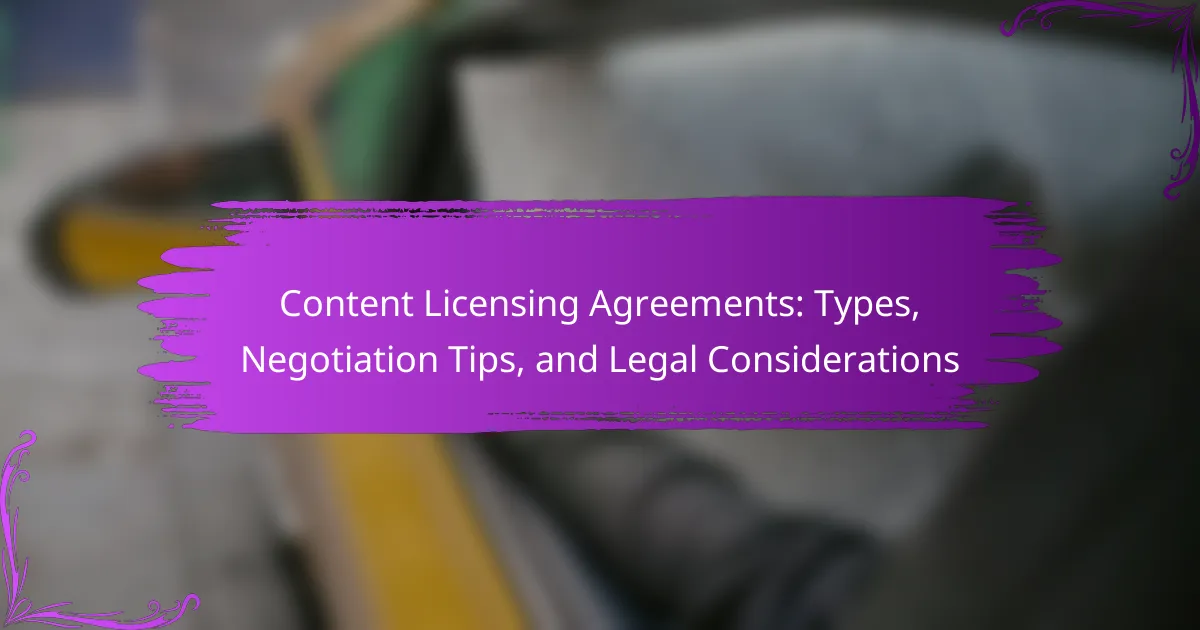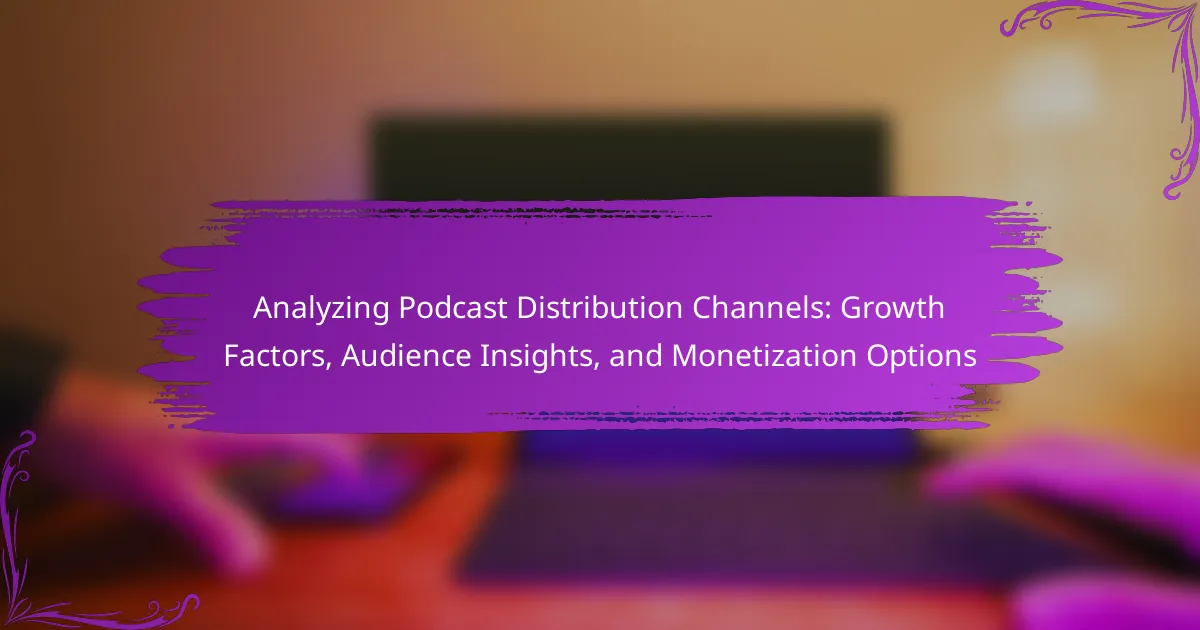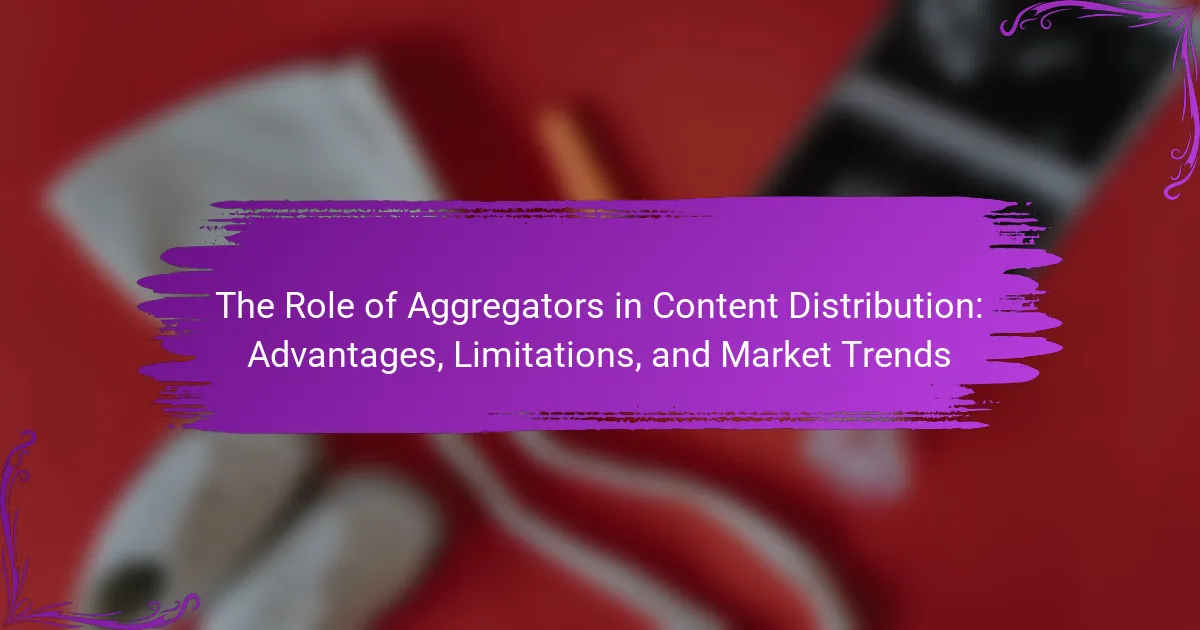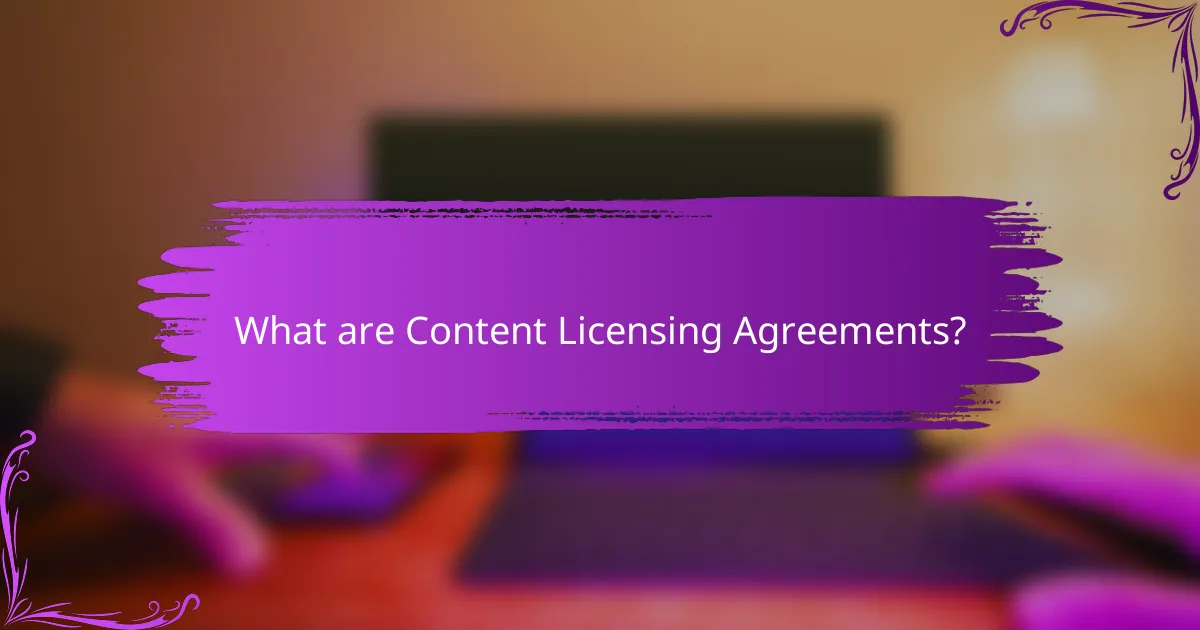
What are Content Licensing Agreements?
Content licensing agreements are legal contracts that allow one party to use the content of another party. These agreements define the terms under which the content can be used, such as duration, scope, and compensation. They can cover various types of content, including text, images, videos, and software. Content licensing agreements protect the rights of the content creator while providing access to users. The agreements often specify how the content can be modified or distributed. They may also include clauses about exclusivity and termination. Content licensing is essential in industries like publishing, entertainment, and technology. Such agreements ensure that creators are compensated for their work while allowing others to benefit from it.
How do Content Licensing Agreements function?
Content licensing agreements function as legal contracts that allow one party to use content owned by another party. These agreements specify the terms under which content can be used, including duration, scope, and compensation. The licensor is the party granting permission, while the licensee is the party receiving the rights. Licensing can involve various forms of content, such as images, videos, and written material. The agreements protect the intellectual property rights of the content owner. They also clarify the rights and responsibilities of both parties. Clear terms help prevent disputes over usage and compensation. Content licensing is common in industries like publishing, advertising, and entertainment.
What are the key elements of a Content Licensing Agreement?
The key elements of a Content Licensing Agreement include the parties involved, scope of the license, payment terms, duration, and termination conditions. The parties involved are typically the licensor and licensee. The scope of the license defines what content is licensed and how it can be used. Payment terms outline the fees and payment schedule. Duration specifies the length of time the license is valid. Termination conditions detail how either party can end the agreement. These elements are essential for clarity and enforceability in content licensing.
How do Content Licensing Agreements differ from other contracts?
Content licensing agreements differ from other contracts primarily in their focus on the permission to use intellectual property. These agreements specifically grant rights to use, reproduce, or distribute content created by another party. Unlike standard contracts that may involve the exchange of goods or services, licensing agreements center on intellectual property rights. They define the scope of usage, duration, and compensation, which are tailored to the content being licensed. Furthermore, content licensing agreements often include specific clauses addressing copyright, attribution, and limitations on usage. This specificity is less common in other types of contracts. For example, a lease agreement does not typically address intellectual property rights, whereas a licensing agreement does. Thus, the nature and purpose of content licensing agreements distinctly set them apart from other contractual forms.
What types of Content Licensing Agreements exist?
There are several types of content licensing agreements. These include exclusive licenses, non-exclusive licenses, and sublicenses. Exclusive licenses grant the licensee sole rights to use the content. Non-exclusive licenses allow multiple parties to use the same content. Sublicenses permit the licensee to grant rights to third parties. Each type serves different purposes in content distribution. Understanding these distinctions is crucial for effective content management.
What is the difference between exclusive and non-exclusive licenses?
An exclusive license grants one licensee the sole rights to use the licensed content. This means that the licensor cannot grant the same rights to anyone else. In contrast, a non-exclusive license allows multiple licensees to use the same content simultaneously. Exclusive licenses often come with higher fees due to their limited nature. Non-exclusive licenses typically have lower costs because they can be shared among various users. The distinction affects how the licensed content can be utilized and monetized. Exclusive licenses are often preferred for unique or high-value content. Non-exclusive licenses provide flexibility and broader access to the content.
What are the characteristics of a synchronization license?
A synchronization license allows the use of music in audiovisual works. It typically involves a fee paid to the copyright holder. This license grants permission to synchronize music with visual media. It is essential for films, TV shows, commercials, and video games. The license specifies the duration of use and the type of media. It may also outline geographic restrictions and distribution methods. Negotiations often include terms regarding royalties and rights. The synchronization license is crucial for legal compliance in the use of music.
How do distribution licenses work?
Distribution licenses allow a licensee to distribute a product or content under specific terms. These licenses define the scope, territory, duration, and any financial arrangements such as royalties. The licensor grants rights to the licensee, enabling them to market and sell the content. This arrangement often requires adherence to quality standards set by the licensor. Distribution licenses can be exclusive or non-exclusive, impacting the competitive landscape. They are legally binding agreements, enforceable in court. Properly drafted licenses protect the interests of both parties involved. A well-structured distribution license can enhance market reach and revenue potential for the licensee.
Why are Content Licensing Agreements important?
Content licensing agreements are important because they establish the legal framework for using creative works. These agreements protect the rights of creators and ensure fair compensation. They clarify the terms of use, such as duration and scope of the content. Clear agreements prevent disputes and misunderstandings between parties. For example, a study by the Copyright Office highlights that licensing agreements help in safeguarding intellectual property rights. This legal clarity fosters collaboration in creative industries. Overall, content licensing agreements are essential for maintaining a balanced relationship between creators and users.
What are the benefits of having a Content Licensing Agreement?
A Content Licensing Agreement provides legal protection for creators and users of content. It ensures that content is used according to agreed terms. This agreement clarifies ownership rights, preventing unauthorized use. It also outlines payment structures, making financial transactions clear. The agreement can enhance collaboration between parties. It reduces the risk of legal disputes over content usage. Additionally, it can increase revenue through licensing fees. Overall, a Content Licensing Agreement benefits both content creators and users by establishing clear guidelines and protections.
How do Content Licensing Agreements protect intellectual property?
Content Licensing Agreements protect intellectual property by legally defining the rights and usage of creative works. These agreements specify who can use the content and under what conditions. They help prevent unauthorized use and reproduction of intellectual property. By outlining the terms, they provide clarity and security for both parties involved. Content Licensing Agreements can also include provisions for compensation or royalties, ensuring that creators are fairly compensated. Legal enforcement of these agreements helps deter infringement. This framework supports the protection of original works in various industries, such as music, film, and publishing.
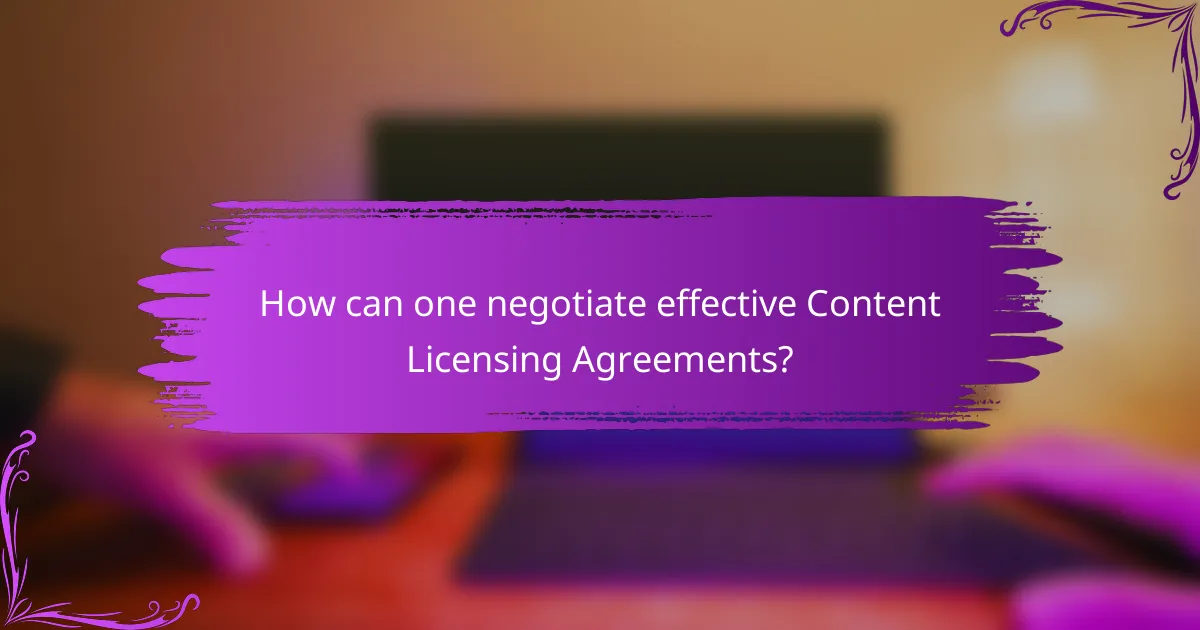
How can one negotiate effective Content Licensing Agreements?
To negotiate effective Content Licensing Agreements, start by clearly defining the scope of use for the content. Specify the duration, territory, and medium in which the content will be used. Establish the financial terms, including upfront fees, royalties, and payment schedules. Ensure that the agreement includes clauses for termination and dispute resolution. Consider including performance metrics to assess the content’s usage and effectiveness. Review legal implications and compliance requirements relevant to the content. Research industry standards for similar agreements to inform your negotiations. Document all terms clearly to avoid misunderstandings.
What strategies can improve negotiation outcomes?
Effective negotiation outcomes can be improved through several strategies. One key strategy is preparation. Thorough preparation allows negotiators to understand their goals and the interests of the other party. Researching the market value and alternatives strengthens their position. Another strategy is establishing a positive rapport. Building trust can facilitate open communication and collaboration. Active listening is crucial. It helps negotiators to understand the other party’s needs and concerns.
Flexibility is also important. Being willing to adapt to new information can lead to creative solutions. Setting clear objectives and limits defines the negotiation’s boundaries. Utilizing win-win solutions ensures that both parties feel satisfied with the outcome.
Finally, following up after the negotiation reinforces relationships and encourages future collaboration. According to a study by the Program on Negotiation at Harvard Law School, effective negotiators use these strategies to achieve better results consistently.
How do you determine your negotiation leverage?
You determine your negotiation leverage by assessing your alternatives and the value of your position. Identify your best alternative to a negotiated agreement (BATNA). A strong BATNA enhances your leverage significantly. Evaluate the needs and interests of the other party. Understanding their priorities can reveal your leverage points. Consider the uniqueness of your offer. A distinctive proposal can increase your bargaining power. Analyze market conditions and competition. Favorable market dynamics can bolster your leverage. Lastly, gauge your relationship with the other party. A strong rapport can enhance your position in negotiations.
What common pitfalls should be avoided during negotiations?
Common pitfalls to avoid during negotiations include lack of preparation and unclear objectives. Negotiators should research all relevant information beforehand. This includes understanding the other party’s needs and limitations. Failing to establish clear goals can lead to misunderstandings. Another pitfall is not being flexible during discussions. Sticking rigidly to initial positions can hinder progress. Additionally, overlooking the importance of building rapport can damage relationships. Poor communication can result in missed opportunities. Lastly, ignoring legal implications can lead to unfavorable terms. Awareness of legal considerations is crucial in content licensing agreements.
What role does communication play in negotiation?
Communication is essential in negotiation as it facilitates understanding and agreement between parties. Effective communication allows negotiators to express their needs clearly. It also enables them to listen to and comprehend the other party’s perspective. Clear communication minimizes misunderstandings that could derail negotiations. Research shows that 70% of successful negotiations stem from effective communication skills. Additionally, non-verbal cues play a significant role in conveying trust and openness. Thus, strong communication skills are crucial for achieving favorable outcomes in negotiations.
How can clear communication enhance negotiation success?
Clear communication enhances negotiation success by ensuring all parties understand their positions and interests. It reduces misunderstandings, which can lead to conflict. When negotiators articulate their needs clearly, they foster trust and collaboration. Studies show that effective communication can increase the likelihood of reaching an agreement by 20%. Moreover, clear communication allows for the identification of common goals. This alignment can facilitate problem-solving and creative solutions. In content licensing agreements, clarity about rights and obligations is crucial. It helps prevent disputes and ensures compliance with legal requirements.
What techniques can facilitate better understanding between parties?
Active listening is a technique that can facilitate better understanding between parties. It involves fully concentrating on the speaker, understanding their message, and responding thoughtfully. This technique helps clarify any misunderstandings. Additionally, paraphrasing ensures that both parties are on the same page. This confirms comprehension and encourages open dialogue. Non-verbal communication also plays a significant role in understanding. Body language and eye contact can enhance the message being conveyed. Establishing common ground fosters a collaborative environment. This shared understanding can lead to more effective negotiation outcomes. Finally, asking open-ended questions encourages deeper discussion. This allows parties to express their viewpoints more freely.
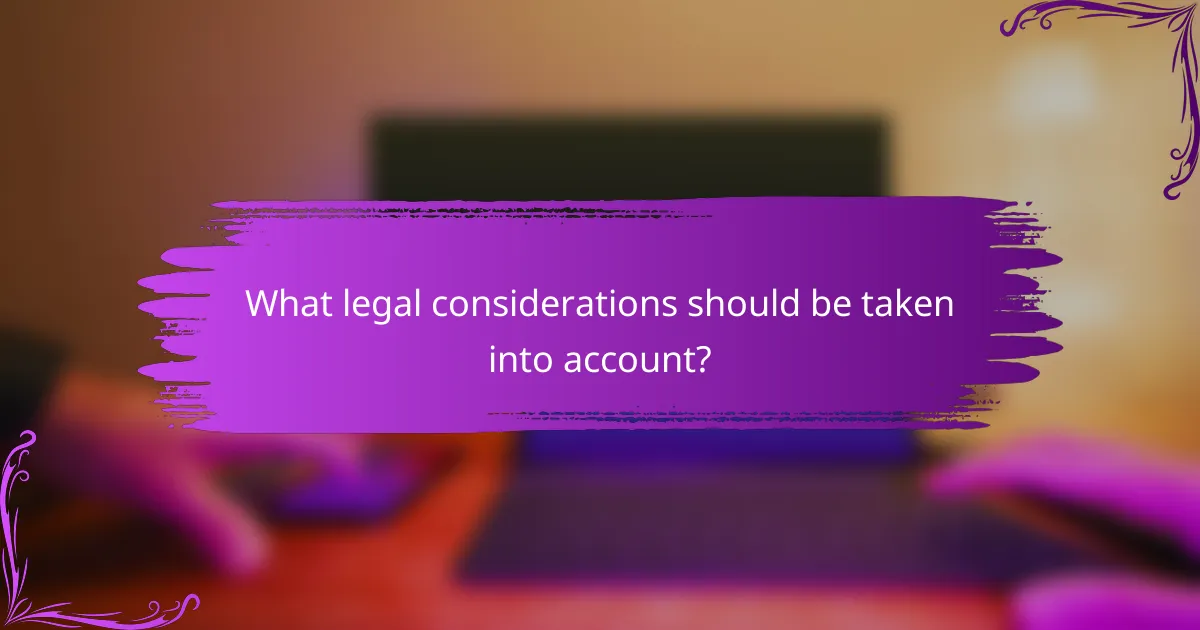
What legal considerations should be taken into account?
Legal considerations in content licensing agreements include copyright ownership, licensing terms, and usage rights. Copyright ownership determines who holds the rights to the content. Licensing terms outline the scope of use, duration, and exclusivity. Usage rights specify how and where the content can be utilized. Additionally, consider jurisdiction and applicable laws that govern the agreement. Compliance with intellectual property laws is crucial to avoid infringement. Contracts should clearly define payment terms and obligations of each party. Dispute resolution mechanisms should also be included to manage potential conflicts.
What are the essential legal terms in Content Licensing Agreements?
Essential legal terms in Content Licensing Agreements include grant of rights, territory, duration, and compensation. The grant of rights specifies what the licensee can do with the content. Territory defines the geographic area where the license is valid. Duration indicates how long the license is effective. Compensation details the payment structure for the licensing agreement. Additionally, there may be terms regarding ownership, warranties, and indemnification. These terms are crucial for protecting the interests of both licensors and licensees in legal agreements.
What does ‘grant of rights’ entail in a licensing agreement?
The ‘grant of rights’ in a licensing agreement refers to the specific permissions given by the licensor to the licensee. This section outlines what the licensee can do with the licensed content. It typically includes rights such as reproduction, distribution, and display. The grant can be exclusive or non-exclusive, impacting the licensee’s ability to use the content. It may also specify territories and duration of use. The precise terms are critical for both parties to understand their rights and obligations. Clear definitions help prevent potential disputes.
How are termination clauses structured in these agreements?
Termination clauses in content licensing agreements typically outline the conditions under which the agreement can be ended. These clauses specify the duration of the agreement, including any renewal terms. They often include provisions for termination for cause, such as breach of contract or failure to meet obligations. Additionally, they may allow for termination without cause, usually requiring advance notice. The clauses can also detail the consequences of termination, including the return of licensed content and any outstanding payments. Clear definitions of terms and conditions help prevent disputes. Courts often uphold these clauses if they are reasonable and clearly articulated.
How do copyright laws impact Content Licensing Agreements?
Copyright laws define the rights of creators over their original works. These laws impact content licensing agreements by establishing the legal framework for how content can be used. Licensing agreements must comply with copyright regulations to be enforceable. They outline the permissions granted to licensees while protecting the rights of copyright holders. Violation of copyright laws can lead to legal disputes and financial penalties. Content that is not properly licensed may result in infringement claims. Therefore, understanding copyright laws is crucial for both licensors and licensees. This ensures that agreements are valid and protect the interests of all parties involved.
What are the implications of copyright infringement in licensing?
Copyright infringement in licensing can lead to significant legal consequences. Infringement may result in lawsuits, financial penalties, and loss of licensing rights. The copyright owner can seek damages, including statutory damages that can reach up to $150,000 per work. Additionally, the infringer may face injunctions that halt the use of the copyrighted material. This can disrupt business operations and damage reputation. Companies may also incur legal fees, which can be substantial. Furthermore, repeated infringement may lead to stricter scrutiny and enforcement actions from copyright holders. Overall, the implications are severe and can jeopardize the financial stability of the infringer.
How can one ensure compliance with copyright regulations?
To ensure compliance with copyright regulations, one must understand and follow the legal requirements set forth by copyright law. This includes obtaining permission from copyright holders before using their work. One should also familiarize themselves with the concept of fair use, which allows limited use of copyrighted material under specific circumstances. Keeping detailed records of permissions and licenses is essential to demonstrate compliance. Regularly reviewing copyright policies and updates is necessary to stay informed about changes in the law. Engaging legal counsel for guidance on copyright issues can provide additional security. Copyright infringement can lead to legal consequences, including fines and litigation, making compliance crucial.
What best practices should be followed when drafting a Content Licensing Agreement?
Best practices for drafting a Content Licensing Agreement include clearly defining the scope of the license. Specify the rights granted, such as reproduction, distribution, and modification. Include details on the duration of the license to avoid ambiguity. Establish payment terms, including royalties or flat fees, to ensure fair compensation. Outline the responsibilities of both parties to prevent misunderstandings. Address termination conditions to provide a clear exit strategy. Incorporate dispute resolution mechanisms to handle potential conflicts efficiently. Lastly, ensure compliance with applicable laws to protect both parties legally.
Content licensing agreements are legal contracts that allow one party to use the content owned by another, defining terms such as duration, scope, and compensation. This article covers the various types of content licensing agreements, including exclusive and non-exclusive licenses, and provides insights into their key elements, such as payment terms and termination conditions. It also discusses the importance of these agreements in protecting intellectual property, strategies for effective negotiation, and essential legal considerations to ensure compliance with copyright regulations. Understanding these aspects is crucial for both content creators and users to maintain a balanced and legally sound relationship.
